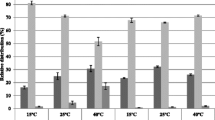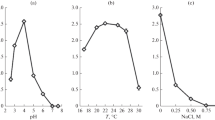Abstract
Thermoacidophilic and halotolerant microorganisms from the Antarctic continent were studied for their lipid modulation under stress growth conditions. Temperature-induced changes in complex lipids and fatty acids of four strains belonging to the genus Alicyclobacillus involved the relative proportions of different polar lipids and the synthesis of ω-cyclohexyl-acyl chains, which were favoured by high temperatures. Studies were carried out on the lipid composition of four strains of extremely halotolerant bacteria belonging to the genus Micrococcus grown at different salt concentrations from 0 up to 4.5 M NaCl. The main lipids found were two unidentified glycolipids and two phospholipids: 1,2 diacylglycero-3-phosphoryl-glycerol (PG) and cardiolipin (DPG). Among the strains analysed, the lipids of the Micrococcus strain Erebus were shown to be strongly influenced by salt concentrations, in that DPG and one glycolipid were absent at a low salt molarity while, under these conditions, PG was the main lipid found. The predominant fatty acids in all halotolerant strains were of the anteiso type; growth under increasing salinity gave rise to an increase in long chain fatty acids and of straight chain fatty acids, while a decrease in iso fatty acids occurred.
Similar content being viewed by others
Author information
Authors and Affiliations
Additional information
Accepted: 20 May 2000
Rights and permissions
About this article
Cite this article
Nicolaus, B., Manca, M., Lama, L. et al. Lipid modulation by environmental stresses in two models of extremophiles isolated from Antarctica. Polar Biol 24, 1–8 (2001). https://doi.org/10.1007/s003000000156
Issue Date:
DOI: https://doi.org/10.1007/s003000000156




